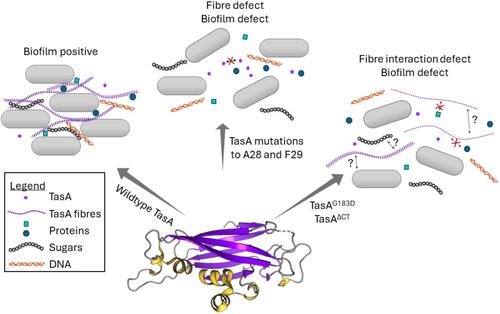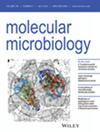TasA 纤维相互作用是枯草芽孢杆菌生物膜结构的必要条件
IF 2.6
2区 生物学
Q3 BIOCHEMISTRY & MOLECULAR BIOLOGY
引用次数: 0
摘要
生物膜的细胞外基质为生物群落提供重要的结构支持,并保护其免受环境干扰。TasA 是枯草芽孢杆菌生物膜基质的一种关键蛋白质,可形成淀粉样和非淀粉样纤维。非淀粉样 TasA 纤维是通过链交换机制形成的,而淀粉样形式则涉及非特异性自组装。我们对 N 端进行了诱变,以评估非淀粉样纤维在生物膜发育中的作用。我们发现,N 端尾部对于结构化生物膜的形成至关重要,这为链交换纤维是生物膜基质中的活性形式提供了证据。此外,我们还证明,仅形成纤维不足以使生物膜具有结构。我们建立了 TasA 与其他细胞外蛋白质成分的相互作用组,并确定了重要的相互作用位点。我们的研究结果为了解蛋白质与基质之间的相互作用如何调节生物膜的发展提供了启示。本文章由计算机程序翻译,如有差异,请以英文原文为准。

TasA Fibre Interactions Are Necessary for Bacillus subtilis Biofilm Structure
The extracellular matrix of biofilms provides crucial structural support to the community and protection from environmental perturbations. TasA, a key Bacillus subtilis biofilm matrix protein, forms both amyloid and non-amyloid fibrils. Non-amyloid TasA fibrils are formed via a strand-exchange mechanism, whereas the amyloid-like form involves non-specific self-assembly. We performed mutagenesis of the N-terminus to assess the role of non-amyloid fibrils in biofilm development. We find that the N-terminal tail is essential for the formation of structured biofilms, providing evidence that the strand-exchange fibrils are the active form in the biofilm matrix. Furthermore, we demonstrate that fibre formation alone is not sufficient to give structure to the biofilm. We build an interactome of TasA with other extracellular protein components, and identify important interaction sites. Our results provide insight into how protein–matrix interactions modulate biofilm development.
求助全文
通过发布文献求助,成功后即可免费获取论文全文。
去求助
来源期刊

Molecular Microbiology
生物-生化与分子生物学
CiteScore
7.20
自引率
5.60%
发文量
132
审稿时长
1.7 months
期刊介绍:
Molecular Microbiology, the leading primary journal in the microbial sciences, publishes molecular studies of Bacteria, Archaea, eukaryotic microorganisms, and their viruses.
Research papers should lead to a deeper understanding of the molecular principles underlying basic physiological processes or mechanisms. Appropriate topics include gene expression and regulation, pathogenicity and virulence, physiology and metabolism, synthesis of macromolecules (proteins, nucleic acids, lipids, polysaccharides, etc), cell biology and subcellular organization, membrane biogenesis and function, traffic and transport, cell-cell communication and signalling pathways, evolution and gene transfer. Articles focused on host responses (cellular or immunological) to pathogens or on microbial ecology should be directed to our sister journals Cellular Microbiology and Environmental Microbiology, respectively.
 求助内容:
求助内容: 应助结果提醒方式:
应助结果提醒方式:


